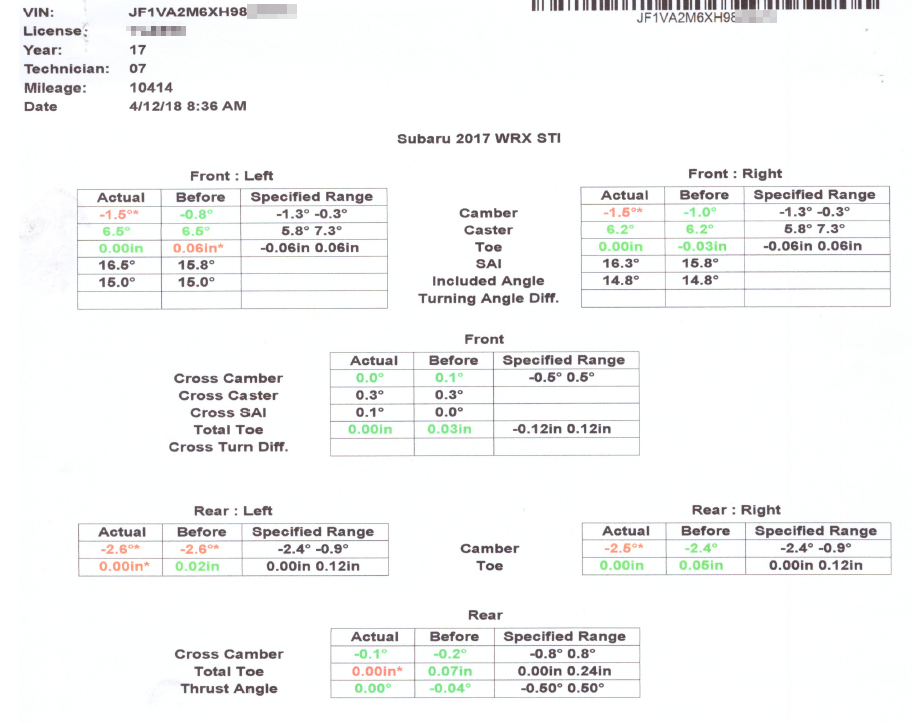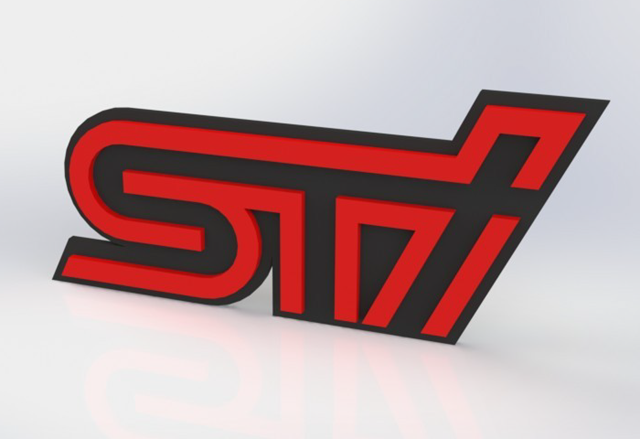This article is constantly updated as I learn more about the 15+ STi and the right alignment for me and my setup.
April 2021
Well, what I have learned since November 2020 is that for an 8k setup -2.6° camber up front and -1.3° is not right. I had tire wear indicative of too much camber causing the insides to wear and a faster rate than the middle or outer sections.
I have since installed 10k springs front and rear and it is time to swing at an alignment again. I will try -2.2° front, max baseline is -2°, so just outside the recommended. For the rear, I’m going to add a little and go with -1.4° rear versus -1.3°. While there were other factors in play at the autocross, the snap oversteer in the wet made the car very difficult to control and a little more camber should help.
November 2020
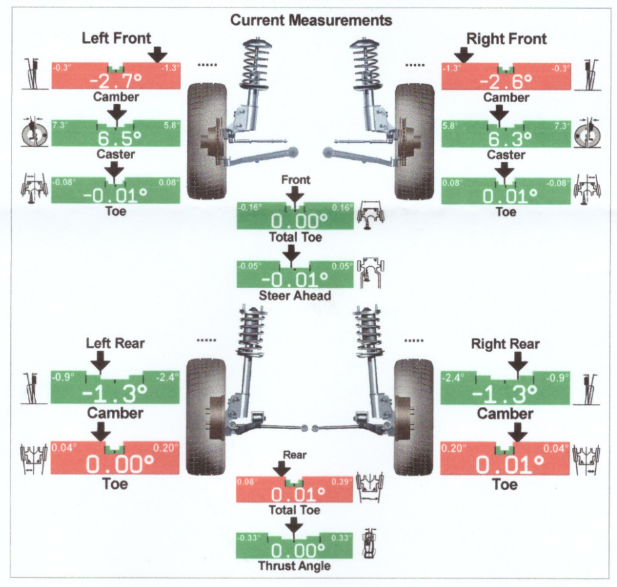
After reading this article on iWSTi, and observing my tires for about 1,000 miles, I believe that the car will benefit from additional addition camber in the front and accordingly, 1/2 of that in the rear. So with the car lowered, -2.6° front and -1.3° rear. From the article…
realize if you stiffen the front suspension further, you will need to decrease (or add more negative camber) to make it work properly. Stock suspension can work in the maximum of its lowest range in the -1.4/-1.5 range. Upgraded springs like RCE blacks and/or mild sway upgrades will need -2.0 to -2.5 to work best. If you have coilovers with stiff springs and any swaybar work, ranges even lower than -2.5 degrees will likely be needed. Very sticky tires, particularly once you get in Hoosier territory levels well in excess of -3.0 up to -3.5 will be needed. Any more than that will do more harm than good, but again, this is a rough range, the “tuning” process is trial and error depending on your setup.
I assume when you say “full” you mean coilovers, which usually are in the 8k/8k. You know that I am running -3.4′ of camber in the front and half that in the rear, or -1.7. I will be going to 8k/9k with a lower rear bar (22/20) from 22/21 which is what I have now, but this actually works well. Tire wear is not a problem. Actually when you have stuff that is very stiff, as you read my alignment post you will see that you can really push the tires (literally) and the front will require that much negative camber. You might want to start with -2.5 and take it from there if all you do is DD though. But even at -3.4 I am not seeing any appreciably uneven wear. Actually it is evening out my wear! The biggest wear thing to worry about is toe more than camber. What can get affected a bit at this camber is braking though. Again it’s a trial and error process but knowing your settings and tires would help.
The rear should be left alone as it works well in the -1.4 range or so but once your camber starts getting in the -2.5 or less range, you want it about half of what the front is. So -3.0 up front would require -1.5 in the rear. On a coilover spring setup that’s not even super stiff, say 8k range, don’t be surprised if the car understeers with a value more positive than -3.0, you’ll need that low camber because remember a very stiff spring will make the tire work very, very hard.
After alignment, I have driven a few miles at -2.6 front, -1.3 rear. The car is much better than a stock alignment. With the Cygnus X-1 coilover upgrade and the alignment, the car feels and drives wonderfully. Onramps and Offramps are noticeably faster and as for the bizarre torque steer push, gone. The car is much more planted and stable. Now a gentle flick will have you two lanes over but I’m no longer fighting just to keep it in one lane. I’ll watch for tire degradation and I look forward to track and autocross in the next couple of months to see how it feels under speed.
March 2020:
After review of several articles, mainly this article, I wanted to have a more track oriented alignment. One commenter pretty well set the base that I’m looking for (emphasis mine). He said:
The front looks good, unless you are prioritizing track over street, but anything beyond about -2.0 is silly unless you are on R-comps. I see they are still making the rear a total pain – that’s where you will still get major improvements – 2.4 is as high as I’ve ever seen on a stock STI. Because the rear geometry gains a LOT of camber on compression (outside wheel in corners), that is way too much in the back to come anywhere near neutral handling since the front loses camber under the same conditions. The rear just digs in and won’t budge until you get to the limit and then it cuts loose none-too-gently – not finely controllable with the throttle. After a lot of playing around, somewhere in the -0.5 to -1.0 range was much, much better in back. On 8K/9K coilovers nirvana was about -2.0F/-0.5R on sticky tires – but not R-comps – at the track. YMMW with stock rates where you walk further along the camber curves in corners (more suspension motion) – depending also on bars, of course.
Looked like good advice. So armed with this knowledge, here’s what I’m thinking:
Front
Camber: -1.75°
Toe: 0°
Rear
Camber: -1.0°
Toe: 0°
At the front, this will be a difference of -0.7°. Whereas in the rear, there will be a +1.85° difference. Thankfully, toe will be unchanged from the base performance alignment I got back in 2018 (see below). Why -2.2° in the front? Well, I am inclined to believe that 2.0° is probably about right, others have mentioned -3° in that article. Another contributor added that anything less than 1° was not noticeable. So, at least for the first alignment with coilovers, I’m apt to split the difference between least and max.
2020 Coilover Alignment
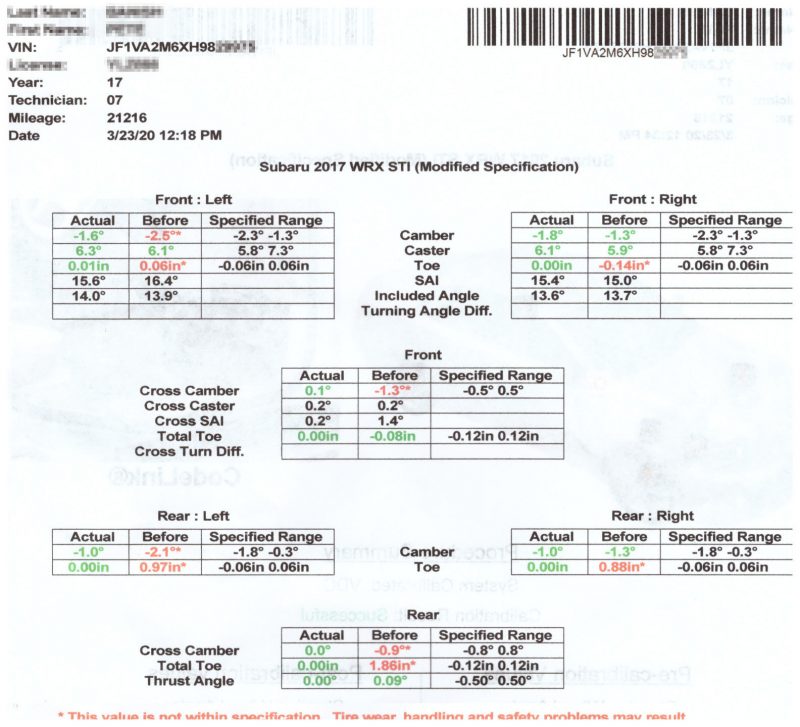
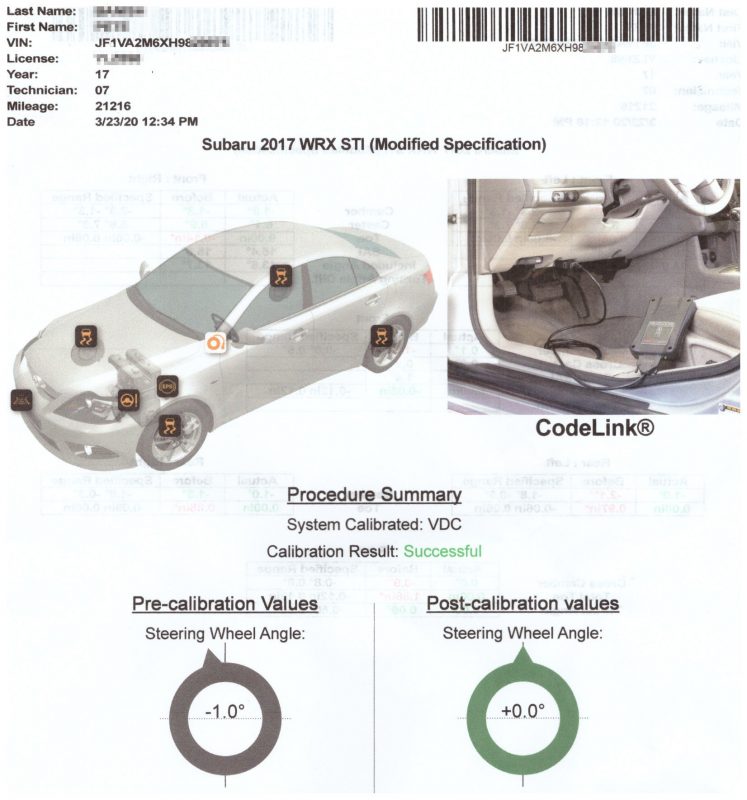
Stock Alignment was:
Front
Camber: -1.5°
Toe: 0°
Rear
Camber: -2.6°
Toe: 0°
